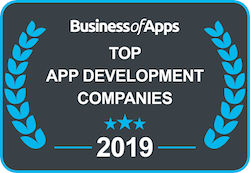In order to produce effective, engaging and enjoyable apps it’s essential to stay informed on how the digital landscape is evolving – to ensure that our products continue to provide genuine value to the people that use them. In this article, we take a look at three trends for 2020 that could completely change the way we use mobile apps.

Voice User Interface and AI technology
Artificial Intelligence (AI) technology is currently used in 4 main areas of mobile products; voice assistants, face unlocking, smart imaging and beautifying – however, there has been a shift in recent years towards combining this intelligence with voice input.
As AI voice technologies continue to improve, becoming more advanced and effective, people begin to change their habits; 50% of all searches are predicted to be made by voice by 2020. This can also be seen in the change of interfaces that AI machines such as Alexa and Google Home utilise; moving from traditional GUI (Graphical User Interface) to VUI (Voice User Interface).
Despite the recent advancement of domestic AI speakers, they remain relatively primitive and do not offer an organic conversation that is representative of communication between two people. It’s always obvious that interactions are between user and machine, and based around an input/response format – limiting its application in everyday use.
Google Duplex, however, has begun to break this mould; successfully making restaurant bookings by phone on behalf of the user without their involvement. The AI-based, human-sounding voice is able to maintain a genuine conversation with a real person to make a booking; a clear sign that the technology is becoming sophisticated enough to potentially challenge the GUI we currently interact with on smartphones. With these developments in voice input and AI technology integration, it could only be a matter of time before we see these technologies appearing in our everyday mobile apps.

Device Synchronisation
The use of mobile apps has traditionally been thought of as an isolated experience, however, there is an ever-increasing need for synchronisation between different digital mediums. Users now require dynamic capabilities across all devices and platforms, and there needs to be a consideration of multiple inputs; whether they’re using their smartphone, a computer or even voice.
Studies have shown that when it comes to e-commerce, approximately 37% of users will begin their research on mobile but then switch to desktop to complete a purchase – there is now a necessity for users to be able to continue their journey regardless of the platform they’re using; synchronisation of a user’s progress across devices is therefore essential in creating a seamless, uninterrupted experience.
A great example of this is Uber; users are able to start their trip with a simple voice command, view their ride progress on their phone and then end it on their watch – one single continuous operation can easily be performed on three different platforms without interruption. Enabling this effortless transition between systems, without delaying the user’s progress, is essential in creating a consistently enjoyable experience from start to finish.

Personalisation
Digital products have transitioned in recent years to be far more personalised, and so the process of building apps to meet the needs of specific users has become increasingly important. Rather than a ‘one size fits all’ experience for all users, the aim is now to present experiences that are customised to the individual; tailoring information to their specific needs at the time of use. This focus on personalisation is incredibly important; it presents an opportunity to connect with users and provide valuable content to them in a way that feels genuine and considered.
Apps can personalise content based on location, present and past searches, and a number of other factors. It can be as simple as showing predicted journey times based on current location (as seen in Citymapper or Uber Eats), or more complex AI and machine learning systems that play a pivotal role behind the scenes; providing tailored recommendations to the user based on their activity within the app.

We can see these systems at work within the Explore page of Instagram. Users are shown content the system believes they will be interested in based on their engagement with other posts, the people they follow and similar accounts to them. This creates an ongoing information loop that feeds into itself; as new content is presented the system identifies what they find most engaging and then shows them more of it. This results in an entirely personal experience, for each individual user, which continually updates as their interests change.
Approximately 65% of app users will delete an app if their first experience of using it is a negative one. With this in mind, the importance of offering them something that appeals to their individual needs and interests is clear; and can often have a huge impact on a products short and long term success.
Conclusion
The digital landscape is one that is constantly changing; with new developments pushing the boundaries of what we think is possible and re-aligning our expectations all the time. While it’s hard to accurately predict how these developments will filter down into the mobile app’s we use every day, we believe it will bring us to be closer and more integrated with our digital products than ever before; through voice interaction, device synchronisation and deeply personalised user experiences.



